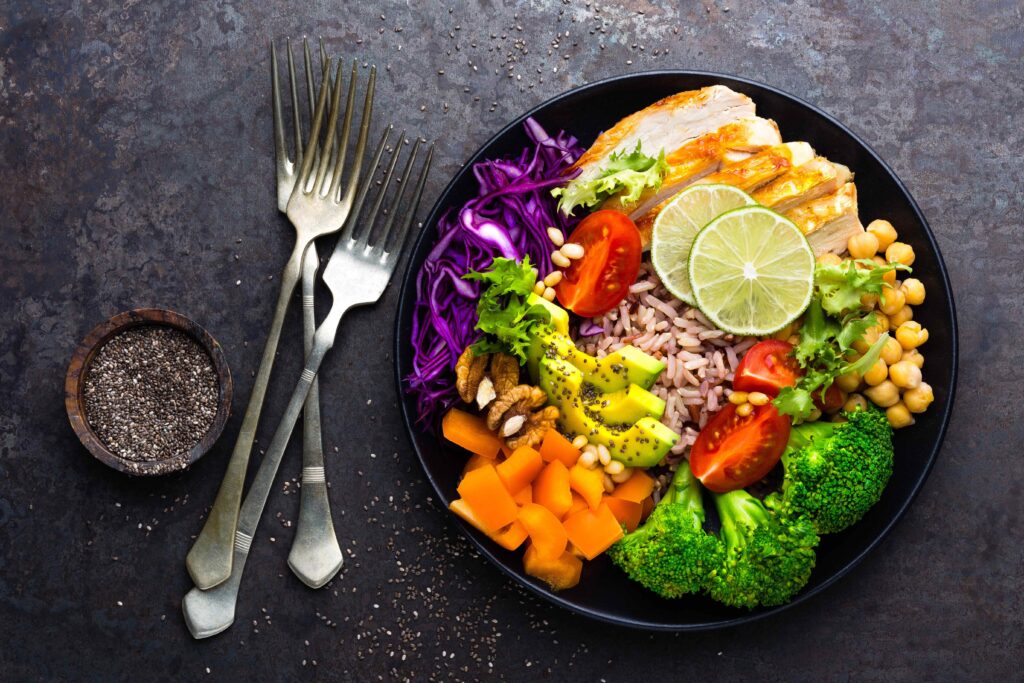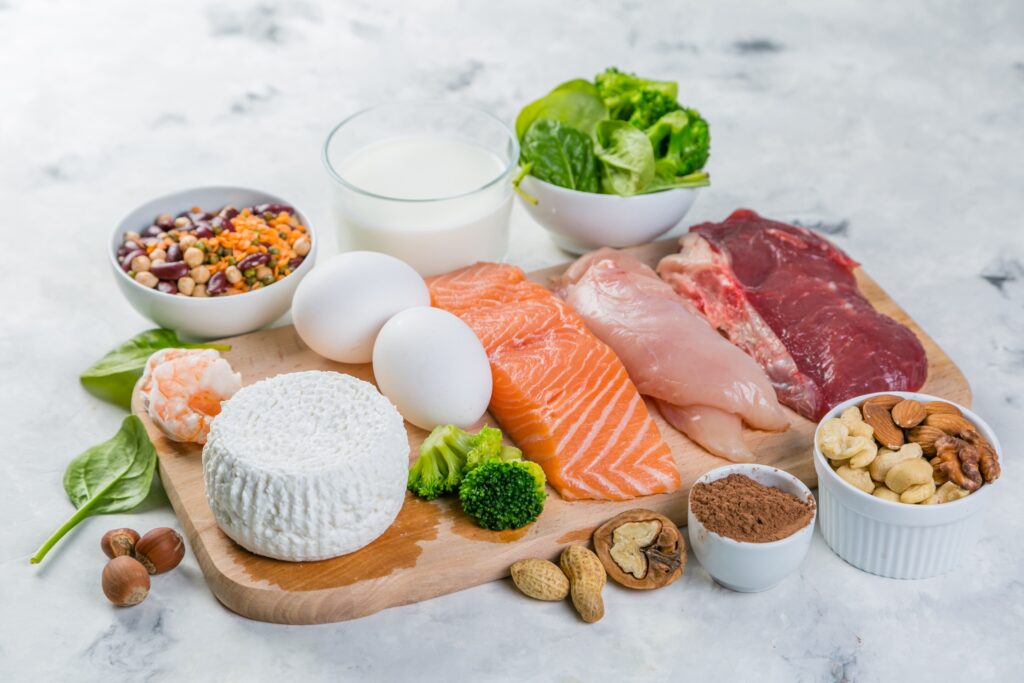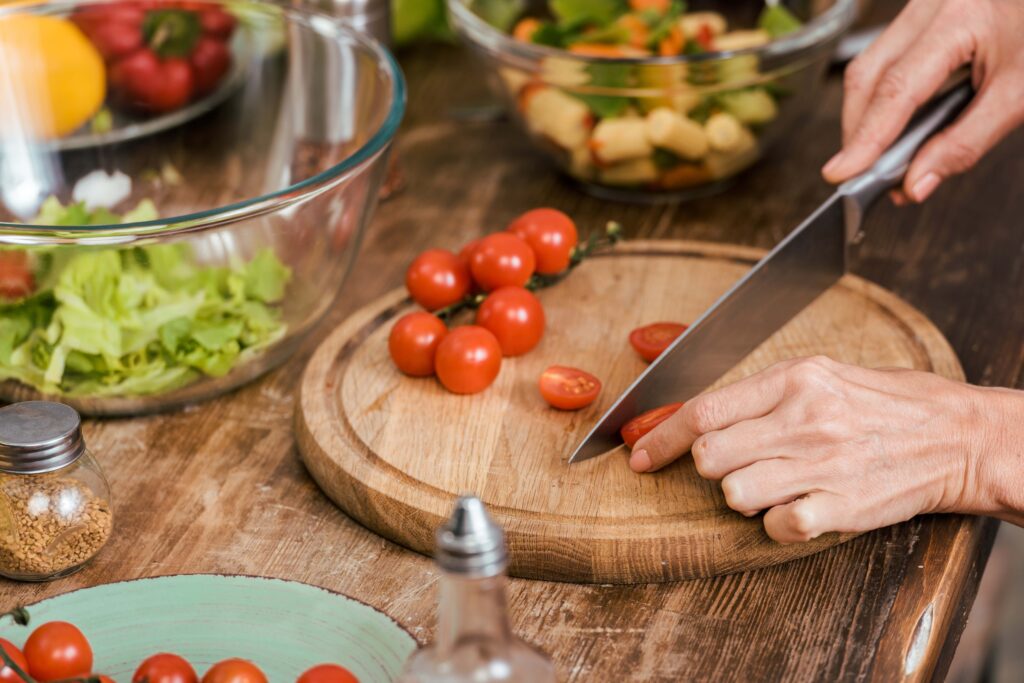Food for Thought: Nutrition in a Nutshell
What’s the foundation of your fitness? Is it how much you can squat, press, and deadlift? How fast you can run a mile? How many pull-ups you can do in a row?
While each of these areas — strength, conditioning, gymnastics — is an important element of overall fitness, the underpinnings of your progress as an athlete — and your health as a person — come not from what you’re doing in the gym but from what you’re doing in the kitchen.

Food can be a loaded topic. Eating and dieting are entwined in cultural heritage and family upbringing, psychology and emotions, and societal pressure. Fad diets come and go, and advice on which foods are going to cause cancer, heart disease, and type 2 diabetes and which foods are going to cure chronic disease and let you live to 103 changes constantly.
But adopting healthier eating habits doesn’t have to be complicated. Here are some nutrition basics and a few quick tips to set you up for success in the kitchen and beyond.
First, the fundamentals:
Mind Your Macros
Being aware of the general composition of the foods you eat and their effects on your body can help you make more mindful nutritional choices.
There are three macronutrients — carbohydrates, protein, and fat — and each has an essential role to play in a healthy diet. Carbohydrates — essentially sugars, predominant in things like rice, beans, bread, pasta, potatoes, and fruits — are the body’s main energy source. Every gram of carbohydrates has 4 calories.
A subset of carbohydrates is dietary fiber, the parts of plant-based foods that the human digestive system cannot fully break down. Vegetables, fruits, whole grains, and nuts are all good sources of fiber, which helps with keeping you full and regulating blood sugar. Nutrition guidelines recommend including at least 25 grams of fiber in your daily diet.
Protein — found primarily in lean meats and fish, eggs, and soy products — is the body’s building block, driving most function at the cellular level and aiding in the growth and repair of muscles and other organs and tissues.
People require a minimum of .36 grams of protein per pound of bodyweight per day to avoid protein deficiency, but protein needs for people leading active lifestyles, and especially for athletes looking to build muscle, are significantly higher, up to 1.2 grams per pound of bodyweight. Every gram of protein has 4 calories.
Fats — found in red meat and some fish, nuts, seeds, oils, avocados, and full-fat dairy products — serve as insulation and energy and also play an important part in hormone production and nutrient absorption. Every gram of fat has 9 calories.
Eat the Rainbow
There are also many micronutrients — vitamins and minerals — that are critical for good health and, except for vitamin D, must come from the diet. Micronutrients include vitamins A, B, C, D, E, and K and minerals like iron, calcium, potassium, magnesium, and zinc. Fortunately, eating a balanced diet with a variety of fruits and vegetables, whole grains, good protein sources, and healthy fats will enable most people to meet these needs without needing to worry whether you’re getting sufficient quantities of specific micronutrients. (If you’re curious whether the foods you’re eating are covering all the essentials, this chart from the FDA lists vitamins and minerals, their roles in the body, what foods have them, and recommended daily intake.)

Knowing your macros and micros is all well and good, but how can you turn this into a healthy, sustainable diet that still allows you to enjoy the act of eating?
Know Your Baseline
When deciding the breakdown of macronutrients day to day, a good starting point is to aim for a diet that derives 45 percent of its calories from carbs, 30 percent from protein, and 25 percent from fat. An example of a meal that fits this prescription is 1 cup of cooked rice, 4 ounces of chicken breast, and a salad with 1-2 tablespoons of an oil-based dressing, adding up to around 600 calories. This is just a guideline, and optimal proportions will vary based on the person and whether their goals are to gain, lose, or maintain weight or body fat.
Whether or not you’re concerned with changing your body, it can be an instructive exercise to spend a week or two weighing, measuring, and tracking your food intake to see what your typical macro breakdown and caloric intake looks like. (Apps like MyFitnessPal, Lose It!, and Cronometer can help with this. *CrossFit Nassau can give you access to a Cronometer pro account)

You might learn something — maybe you’re getting far less protein than you thought, and adding some to your diet will help you break through a strength plateau. Maybe you’re eating a lot more fat than you realized, and you’ve identified an easy place to cut back if you’re trying to drop a few pounds. Or many you’re not getting nearly enough carbs, explaining why you often feel sluggish during WODs.
And ultimately, losing or gaining weight comes down to being in a calorie deficit (burning more calories than you consume) or calorie surplus (consuming more calories than you burn), so knowing your starting point is critical to knowing how many calories to cut or add. The recommendation is generally to not add or cut by more than 10 percent, so if, for example, you’re starting from a base of 2,000 calories per day, you’d drop to no lower than 1,800 calories per day in order to begin losing weight.

Seek Satiety
Aim to fill your meals with nutrient-dense, whole foods that are going to keep you full and satisfied until your next meal or snack. Generally, this means including protein, fiber, and fats in each meal.
Protein is the king of keeping you full, and most people should aim to include at least 20-30 grams of protein in each meal.
This is especially true of breakfast, which in the typical American diet tends to be high in fats and sugars but low in protein. Research has shown, however, that high protein breakfasts can help control your appetite throughout the day and limit late-night cravings. Good sources of protein to work into your breakfast routine include Greek yogurt, a mix of eggs and egg whites, cottage cheese, tofu, or even mixing a scoop of your favorite protein powder in with your oatmeal or smoothie.
Fiber can also help keep you full, due both to the volume consumed and to the digestion-slowing effects it has in the gut. Consider broccoli: 300 grams of broccoli is roughly 100 calories and 8 grams of fiber. That’s more than half a pound of food — and more than your daily dose of vitamins C and K — for just a few more calories than the cream in your morning coffee.
Fat will also keep you full, but not all fat was created equal. Try to fill your diet with fat sources rich in omega-3 fatty acids — a nutritionally essential compound that our body cannot produce on its own. Fatty fish like salmon, sardines, and anchovies; flax, chia, and hemp seeds; walnuts; and grass-fed beef are all examples of foods rich in omega-3s.
Similar to omega-3s, your body also requires but cannot produce omega-6 fatty acids. You can get these from foods like eggs and peanut butter, but they’re also abundant in the types of highly processed vegetable and seed oils used heavily in restaurants and in other processed foods. Most people get more than enough omega-6 fats and not nearly enough omega-3s.

Remember that fats are very calorie-dense, and it can be easy to add a lot of calories from fat to your meals without realizing it. That tablespoon of olive oil you used to coat your pan, for example, clocks in at 120 calories. By contrast, you’d need arund 3 ounces of cooked chicken breast or more than a pound of spinach to get to 120 calories of those foods.
Watch Out for Sneaky Sugar
Added sugar — sugar that is not naturally occuring in food but rather that is added during processing or preparation — includes the table sugar you might add to your coffee or tea, but also “natural” sweeteners like honey and maple syrup.
Crossfit’s statement on nutrition — “Eat meat and vegetables, nuts and seeds, some starch, little fruit, and no sugar” — makes its stance on added sugar pretty clear: you shouldn’t have any. In practice, this is easier said than done, and a little bit of sugar isn’t going to upend an otherwise balanced and healthy diet. American dietary guidelines suggest a maximum of 25 grams of added sugar per day for women and 36 grams per day for men.
Check the labels the next time you’re shopping for your favorite sauces, salad dressings, dried, canned, and frozen fruits, granola bars, and cereals. These foods frequently have a significant amount of added sugar, but lower and no added sugar options are out there if you shop carefully.
Take It One Step at a Time
Trying to completely overhaul your diet all at once is setting yourself up for failure. Instead, budget your willpower by making one small adjustment at a time. Once that change becomes a habit rather than a battle of wills, then make your next adjustment. Over time, your series of small changes will make a huge difference.

For example, maybe you start by trying to reduce and, eventually, eliminate sugary sodas from your diet by replacing them with flavored sparkling water. Turning one 12-ounce Coke per day into a 0-calorie seltzer has already cut more than 1,000 calories and 273 grams of added sugar per week.
Maybe the next change is adding a good source of protein to your breakfast, or adding a side of vegetables with your lunch or dinner. If you find yourself frequently eating out, try to add one more day per week where you’re instead opting for a home-cooked meal.
Before long, these habits won’t be part of a “diet” or a “challenge” you’ve set for yourself — it’s just the way you eat.
Be Prepared
Lots of less than optimal food choices are made due to convenience. If you’re tired from a long day at work, and your choices are spending an hour in the kitchen preparing a meal from scratch or checking your phone for the quickest Doordash options, that second option is going to win out a lot of the time. If you show up at work with no lunch plan, that leftover birthday cake sitting in the office kitchen is going to become increasingly tempting. You can avoid situations like this by committing an hour or two each week to meal prep, creating full meals that can be packaged up then quickly reheated when you’re ready to eat them.
For lunches and dinners, cook one or two proteins, for example some chicken or ground turkey; a starch like rice or sweet potatoes; and your favorite vegetables. Mix and match, portion each component out, and they’re ready to go — just reheat and add your favorite sauces and seasonings at meal time. Alternatively, make a big batch of a hearty soup or chili in a slow cooker, then freeze or refrigerate individual portions for later use.
For breakfasts, overnight oats are one great option, and egg-based dishes like crustless quiches can be made in batches and frozen. You can also wash and chop fresh veggies and fruits in advance to make for quick and easy snacks during the week.
 Being prepared starts at the grocery store. Before you shop, think about your schedule for the week and make at least a rough plan for what you’ll have for each meal and what ingredients you’ll need. In addition to full meals, stock your pantry and fridge with healthy and easy snack options like fresh fruit, nuts, or veggies or whole grain crackers and hummus. Protein bars can also be an ok option in a pinch, but make sure you’re picking brands that are not also filled with added sugars and fats.
Being prepared starts at the grocery store. Before you shop, think about your schedule for the week and make at least a rough plan for what you’ll have for each meal and what ingredients you’ll need. In addition to full meals, stock your pantry and fridge with healthy and easy snack options like fresh fruit, nuts, or veggies or whole grain crackers and hummus. Protein bars can also be an ok option in a pinch, but make sure you’re picking brands that are not also filled with added sugars and fats.
Set Goals Within Your Control
It’s easy to become discouraged and lose motivation if you’re constantly setting goals then failing to meet them. Avoid this cycle of negativity by basing your goals on process, not result. You can say, “I want to lose 5 pounds this week,” but even if you do everything “right,” it still might not happen — it’s an outcome you can’t fully control.
What you can control is the process: frame your goals as “I’m going to eat vegetables with every meal this week” and “I’m going to go for a walk every day.” Stay motivated by focusing on goals that are achievable and within your control. The results you want will come.
Slow Down & Focus on the Food
When you eat very quickly, your body doesn’t have time to recognize that it’s full before you keep shoveling in more food. Set your fork down between mouthfuls, and chew and swallow your food completely before going in for the next bite.
Try not to make meals and snacks a multi-tasking affair. Eating mindlessly while watching TV or playing on your phone is a recipe for overeating. Sit down at the table and take the time to enjoy your food.
A Healthy Diet Isn’t All or Nothing
There’s nothing wrong with enjoying the occasional treat, and one weekend of overindulgence doesn’t mean your diet is doomed. Don’t intentionally undereat the next day to “make up for it”; just try to get back on track with your regular healthy habits.
As for those one-off cravings, It’s often better to honor them than to try to eat around them. Say you really want a brownie. But you’re trying to be healthy, so instead you go for an apple. You’re still not satisfied, so then you grab some nuts, then some chips, and before you know it you’re still unsatisfied but you’ve consumed more calories than you would have if you’d just had the brownie in the first place.
And there’s always room for compromise. Maybe you still have that slice of pizza, but supplement with a salad rather than going for a second slice. Maybe you still go for that cookie, but add some berries on the side to add some fiber and micronutrients to your dessert. If you’re not able to enjoy the foods you’re eating, your diet is likely to be unsustainable in the long run.
The Tip of the Iceberg
These general tips can help set you on a path to healthier eating, but nutrition is a complicated and constantly evolving science, and every individual has unique goals and needs surrounding health, fitness, or appearance, food preferences and sensitivities, and ways of eating that work best for them. If you’re interested in guidance specific to your weight loss or body composition goals and nutritional needs, talk to a coach about CFN’s customized nutrition coaching.

Leave a Reply